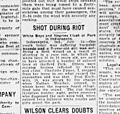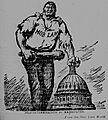Red Summer facts for kids
The Red Summer was a period in 1919 when many cities across the United States saw widespread violence and riots. These events often involved white groups attacking black communities. The name "Red Summer" was created by James Weldon Johnson, a civil rights activist and writer. He worked for the National Association for the Advancement of Colored People (NAACP) and helped organize peaceful protests against the violence.
Most of the attacks were by white people against black people. However, many African Americans fought back, especially in the Chicago and Washington, D.C. race riots. In Chicago, 38 people died, and in Washington, D.C., 15 people died. Many more were injured, and there was a lot of damage to buildings in Chicago. The most deaths happened in a rural area near Elaine, Arkansas. There, about 100 to 240 black people and five white people were killed. This terrible event is now known as the Elaine massacre.
Why Did the Red Summer Happen?
The riots and killings of the Red Summer grew from several problems after World War I.
- Soldiers Coming Home: Both black and white soldiers were returning home from the war.
- Job Competition: There was a tough time for jobs and money. This led to more competition for jobs and homes between white and black Americans.
- Worker Problems: There were also many problems between workers and their bosses. Some factory owners used black people as strikebreakers (people who work during a strike). This made white workers even more angry.
How the News Covered It
Newspapers and the U.S. government reported a lot on these riots and killings. They were worried about new ideas like socialism and communism spreading among black civil rights groups. This fear came after the 1917 Bolshevik Revolution in Russia. They also worried about foreign anarchists who had bombed the homes and businesses of important people and government leaders.
Images for kids
-
A family leaving their damaged home after the Chicago race riot of 1919
-
A cartoon about "Mob Law" in Washington, D.C., from the New-York Tribune, July 27, 1919
See also
 In Spanish: Verano Rojo de 1919 para niños
In Spanish: Verano Rojo de 1919 para niños






